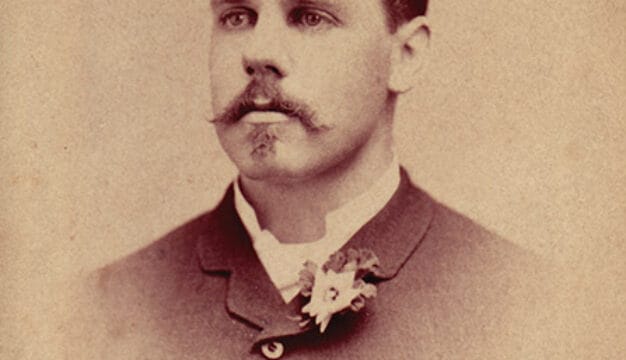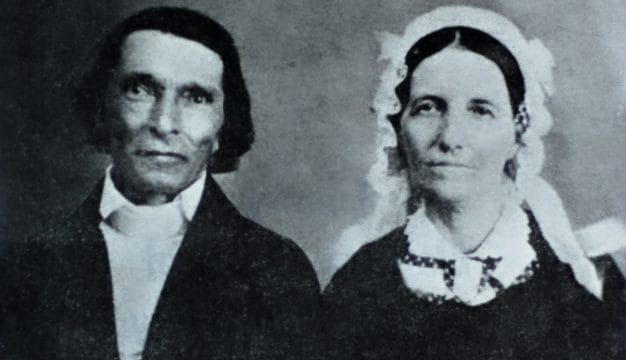Jupiter C
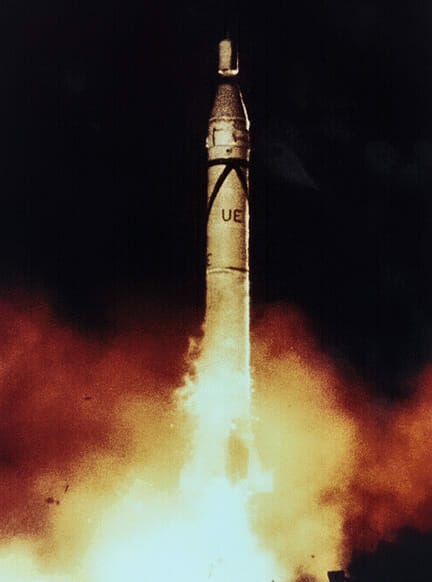 Explorer I Launch
The Jupiter C was a liquid-fuel rocket developed by the Army Ballistic Missile Agency (ABMA) in Huntsville, Madison County. It propelled Explorer I, the first American satellite, into orbit around the Earth on January 31, 1958.
Explorer I Launch
The Jupiter C was a liquid-fuel rocket developed by the Army Ballistic Missile Agency (ABMA) in Huntsville, Madison County. It propelled Explorer I, the first American satellite, into orbit around the Earth on January 31, 1958.
Prior to the formation of the National Aeronautics and Space Administration (NASA) in 1958, the military services had primary responsibility for rocket development. Although there were some cooperative projects, most of these projects were competitive, and Huntsville’s Redstone Arsenal became the army’s missile development center in 1950. The core of the Redstone development group was a team of German rocket engineers, led by Wernher von Braun, who had come to the United States after World War II. The army transferred the group to Huntsville from Fort Bliss, Texas, where it had been working with American contractors on rocketry projects based on the technology of Germany’s V-2 rocket since the end of the war.
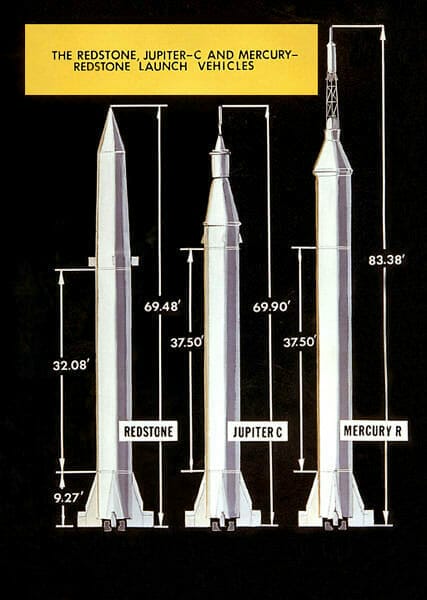 Rocket Comparison Chart
Von Braun’s team, augmented by contract personnel, civil servants, and American engineers, formed the Ordnance Guided Missile Center, the predecessor of ABMA. The group’s central task was the development of the Redstone rocket, conceived as a surface-to-air missile with a range of 100 miles; it essentially would be the forerunner of the Jupiter. The Redstone incorporated technology produced by von Braun in Germany and used a modified version of the engine developed by military contractor North American Aviation for the U.S. Air Force’s Navaho cruise missile program. Rocket design took place in-house, but Chrysler Corporation was contracted to build research and development models and later operational missiles. The operational Redstone was 69.3 feet long and generated 78,000 pounds of thrust, with a range of 175 miles. Defense funding was limited because of the Korean War, and the group had to be creative. After receiving a bid of $75,000 to build an apparatus known as a test stand on which to test the rocket, the team built a model with materials costing only $1,000 and dubbed the “Poor Man’s Test Stand.” It remains on display as a historical landmark at Huntsville’s Marshall Space Flight Center.
Rocket Comparison Chart
Von Braun’s team, augmented by contract personnel, civil servants, and American engineers, formed the Ordnance Guided Missile Center, the predecessor of ABMA. The group’s central task was the development of the Redstone rocket, conceived as a surface-to-air missile with a range of 100 miles; it essentially would be the forerunner of the Jupiter. The Redstone incorporated technology produced by von Braun in Germany and used a modified version of the engine developed by military contractor North American Aviation for the U.S. Air Force’s Navaho cruise missile program. Rocket design took place in-house, but Chrysler Corporation was contracted to build research and development models and later operational missiles. The operational Redstone was 69.3 feet long and generated 78,000 pounds of thrust, with a range of 175 miles. Defense funding was limited because of the Korean War, and the group had to be creative. After receiving a bid of $75,000 to build an apparatus known as a test stand on which to test the rocket, the team built a model with materials costing only $1,000 and dubbed the “Poor Man’s Test Stand.” It remains on display as a historical landmark at Huntsville’s Marshall Space Flight Center.
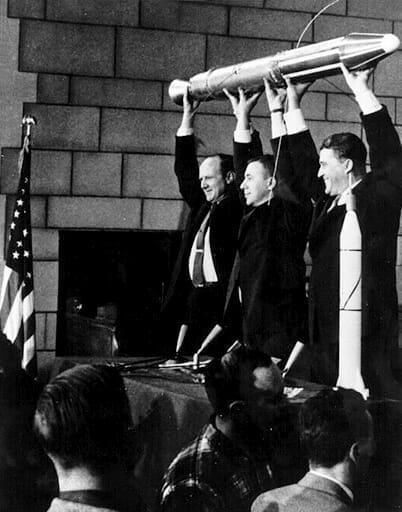 Explorer I Launch Celebration
In 1955, the United States initiated plans to launch a satellite to orbit the Earth. The main competitors for government backing were the Army’s Redstone, the Navy’s Viking, and the Air Force’s Atlas missile programs. Although the Army’s program included the proven Redstone missile, an Army-industry panel selected the Navy’s Viking, and the Navy established Project Vanguard to carry out the mission. In 1956, the Ordnance Guided Missile Center was renamed the Army Ballistic Missile Agency, and Maj. Gen. John B. Medaris became its commanding officer. Medaris, an effective bureaucratic infighter, and von Braun, a charismatic leader and talented engineer, gave the new organization dynamic leadership. Bridling under administrative restrictions, they found ways to continue developing Jupiter.
Explorer I Launch Celebration
In 1955, the United States initiated plans to launch a satellite to orbit the Earth. The main competitors for government backing were the Army’s Redstone, the Navy’s Viking, and the Air Force’s Atlas missile programs. Although the Army’s program included the proven Redstone missile, an Army-industry panel selected the Navy’s Viking, and the Navy established Project Vanguard to carry out the mission. In 1956, the Ordnance Guided Missile Center was renamed the Army Ballistic Missile Agency, and Maj. Gen. John B. Medaris became its commanding officer. Medaris, an effective bureaucratic infighter, and von Braun, a charismatic leader and talented engineer, gave the new organization dynamic leadership. Bridling under administrative restrictions, they found ways to continue developing Jupiter.
Vanguard failures combined with the successful launch of the Sputnik I satellite by the Soviet Union on October 4, 1957, to give ABMA its opportunity. Incoming Secretary of Defense Neil McElroy was visiting Redstone Arsenal when he learned of the successful Sputnik launch. Von Braun and Medaris sat on either side of him at a dinner that night and lobbied for a chance to deploy Jupiter, pledging that they could do so within four months. After the Soviets launched Sputnik II with the dog Laika aboard on November 3, the Defense Department consented and set a launch date of January 29, 1958.
Thus Jupiter C—or technically a modified Jupiter C designated Juno I because of the addition of another booster stage—became the missile on which American hopes rested. The Jet Propulsion Laboratory (JPL) in Pasadena, California, developed the Explorer I satellite, and a JPL–Redstone Arsenal team devised the solid-fuel upper stages of the launch vehicle. On January 31, 1958, only two days later than scheduled, ABMA’s Juno I, though often referred to as Jupiter C, carried Explorer I into orbit. The satellite was loaded with scientific instruments to measure cosmic rays, temperatures, and the impact of micrometeorites and is credited with detecting the existence of the Van Allen radiation belts around the Earth. The rocket would also successfully launch the Explorer III and IV, but failed to take to orbit Explorer II and V.
Jupiter remained the Army’s main line of launch vehicles, competing with the Air Force’s Thor and Atlas rockets. All three were used as first-stage launch vehicles, and the Redstone rocket became the launch vehicle in the Mercury-Redstone series that first carried Americans into space. A year and a half after the formation of NASA, on July 1, 1960, ABMA transferred to the newly established George C. Marshall Space Flight Center, NASA’s installation within the boundaries of Redstone Arsenal. The Jupiter development team went on to develop the Saturn V rocket, the propulsion system of the Apollo Program that carried American astronauts to the Moon.
Additional Resources
Bilstein, Roger E. Stages to Saturn: A Technological History of the Apollo/Saturn Launch Vehicles. Washington, D.C.: Scientific and Technical Information Branch, National Aeronautics and Space Administration (SP-4206), 1980.
Dunar, Andrew J., and Waring, Stephen P. Power to Explore: A History of Marshall Space Flight Center, 1960-1990. Washington, D.C.: Scientific and Technical Information Branch, National Aeronautics and Space Administration (SP-4313), 1999.
Hunley, J.D. The Development of Propulsion Technology for U.S. Space-Launch Vehicles, 1926-1991. College Station: Texas A&M University Press, 2007.


